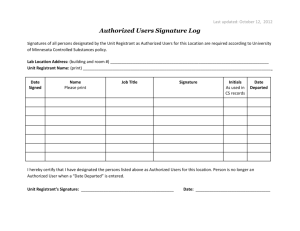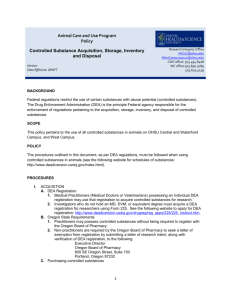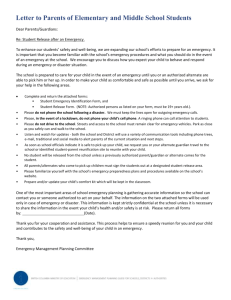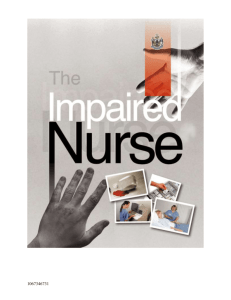Sample Standard Operating Procedures for Controlled Substances
advertisement
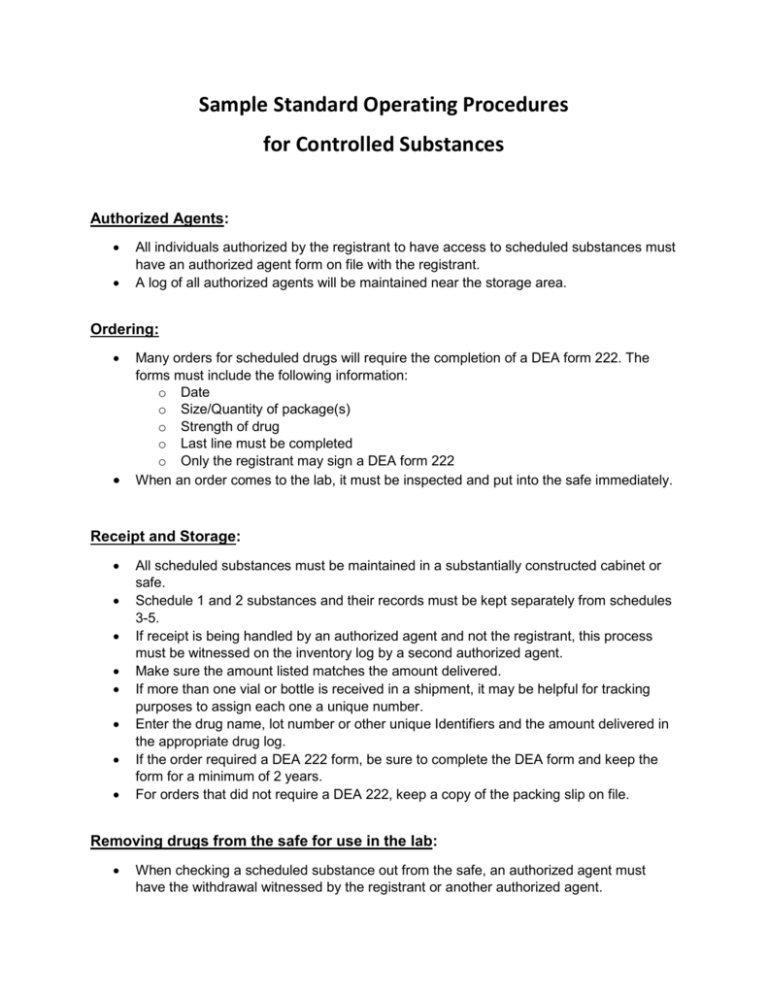
Sample Standard Operating Procedures for Controlled Substances Authorized Agents: All individuals authorized by the registrant to have access to scheduled substances must have an authorized agent form on file with the registrant. A log of all authorized agents will be maintained near the storage area. Ordering: Many orders for scheduled drugs will require the completion of a DEA form 222. The forms must include the following information: o Date o Size/Quantity of package(s) o Strength of drug o Last line must be completed o Only the registrant may sign a DEA form 222 When an order comes to the lab, it must be inspected and put into the safe immediately. Receipt and Storage: All scheduled substances must be maintained in a substantially constructed cabinet or safe. Schedule 1 and 2 substances and their records must be kept separately from schedules 3-5. If receipt is being handled by an authorized agent and not the registrant, this process must be witnessed on the inventory log by a second authorized agent. Make sure the amount listed matches the amount delivered. If more than one vial or bottle is received in a shipment, it may be helpful for tracking purposes to assign each one a unique number. Enter the drug name, lot number or other unique Identifiers and the amount delivered in the appropriate drug log. If the order required a DEA 222 form, be sure to complete the DEA form and keep the form for a minimum of 2 years. For orders that did not require a DEA 222, keep a copy of the packing slip on file. Removing drugs from the safe for use in the lab: When checking a scheduled substance out from the safe, an authorized agent must have the withdrawal witnessed by the registrant or another authorized agent. Take only the amount needed for the experiments planned and be sure to record any waste/spillage on the inventory log. Compounded solutions containing a controlled substance prepared within the laboratory should be labeled with the following: o Name of the controlled substance(s) o Lot number(s) o Date vial opened or prepared o Final concentration(s) and amount(s) per container o <7 day expiration date, unless product stability data suggests otherwise When using the drug, enter the amount used for procedures performed immediately after the procedures have been completed. Make sure the amount of drug used, the purpose for using the drug, and the amount remaining is recorded properly in the drug log. Also, make sure that you keep a running tabulation of drug use for each procedure in your lab book or surgery/testing sheets as a back-up record. Don’t forget to log any drug that is wasted/lost during use in the lab, this includes amounts left in syringes as this typically cannot be put back into your stock vial. Be sure to have final use and waste witnessed by another authorized agent. Records: As mentioned previously, schedule 1 and 2 drugs and records must be kept separately from schedules 3-5. Records should be maintained for at least 2 years. Records must be readily accessible and also must be stored securely, for this reason it is best to store them in a locked cabinet near the storage area. Biennial Inventory: Remaining inventories must be reported once every two years. Audits: Registrants or authorized agents are encouraged to perform weekly to monthly audits of their controlled substance inventory to accurately track inventory and avoid discrepancies. One authorized agent and an authorized agent witness must complete the inventory audit. At the conclusion of the audit, the authorized agent shall document the date, their initials, and a statement indicating the records to be accurate or reason for discrepancy. Registrants must review records that fail to reconcile in an attempt to identify recording errors or missing transactions. Inventory discrepancies are generally due to: o Mathematical errors o Non-recorded administration or dispensing transactions o Errors in receiving and general inventory updates Disposing of expired drugs and waste: Expired drugs must disposed of using an authorized reverse distributor or similar organization OR by rendering the drugs unrecoverable. Most drug solutions can be rendered unrecoverable by dumping them into kitty litter. Kitty litter should be kept in a container that minimizes dust formation. For syringes containing unrecoverable drug, they may be placed into a sharps container form which they cannot be recovered. Remember to have any waster estimates and drug disposals witnessed by another authorized agent or the registrant. Theft or Loss of Scheduled Substances: Significant losses or theft must be reported immediately to the DEA and State of Michigan Bureau of Health Professions Investigation Division. In addition, the Central Michigan University Police Department, the OVPR compliance officer, and the Controlled Substance Program Coordinator must be contacted. The registrant should provide initial notification in writing of the loss or theft to the DEA Detroit Field office. Immediately fax to the Detroit field office. Detroit DEA Field Office 431 Howard Street Detroit, MI 48226 Phone: (313) 234-4000 Fax: (313) 234-4149 Use online DEA Form 106: Report of Loss or Theft to follow up with the faxed report In addition to the DEA, loss or theft must be reported to the State of Michigan Bureau of Health Professions Investigation Division All in transit losses and lost DEA Form 222s must be reported to the DEA. During initial inquiries into the incident, registrants must complete an online DEA Form 106: Report of Theft or Loss of Controlled Substances Form 106. A report must still be filed if lost or stolen material is recovered. Contact the Michigan Bureau of Health Professions Investigation Division at (517) 373-1737 or bhpinfo@michigan.gov for questions regarding theft or loss and submission of DEA Form 106 to the State of Michigan. Minor discrepancies in inventory that are not attributed to theft or loss can be reconciled on the inventory report with proper notation. A DEA Form 106 does not need to be submitted for this purpose. However, the DEA should be contacted for guidance on how to proceed with such matters. The DEA recommends a registrant should determine significant loss in relation to controlled substance activity, patterns or trends of loss, and loss of controlled substances with high risk of diversion. Refer to the DEA Office for Diversion Control for more information.
